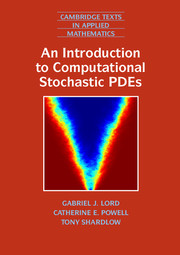7 - Random Fields
Published online by Cambridge University Press: 05 July 2014
Summary
We now turn from stochastic processes {u(t): t ≥ 0}, which are families of random variables for a one-dimensional parameter t, to random fields {u(x): x ∈ D ⊂ ℝd}, which are families of random variables for a d > 1 dimensional parameter x. Random fields are important in many applications and are used, for example, to model biological tissue, velocity fields in turbulent flows, permeability of rocks or other geological features, as well as temperature, rainfall and ocean heights in climate modelling. Depending on the application, random fields have different statistical characteristics, which we describe in terms of the mean E[u(x)] and covariance Cov(u(x), u(y)). Important cases are stationary random fields (where the mean is constant and the covariance depends only on x − y), isotropic random fields (the covariance depends only on the distance ∥x − y∥2), or anisotropic random fields (the covariance is directionally dependent).
Random fields once constructed are typically used to obtain other quantities, such as cell movement, fluid pressures, vegetation patterns, temperatures, and flow rates, often through solving a PDE. A PDE is a differential equation with derivatives with respect to x ∈ ℝd for d > 1 and the solution u(x) of a PDE with random coefficients is a family of random variables parameterized by x. In other words, the solution u(x) is also a random field. In Chapters 9 and 10, we develop solution methods for such PDEs and we show how to calculate statistics (e.g., mean and variance) of quantities derived from the PDE and hence quantify uncertainty in the particular PDE model.
- Type
- Chapter
- Information
- An Introduction to Computational Stochastic PDEs , pp. 257 - 313Publisher: Cambridge University PressPrint publication year: 2014
- 3
- Cited by

